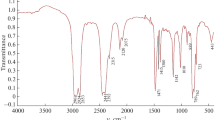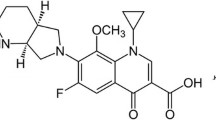Abstract
Ion selective electrodes (ISEs) based on polymer plasticized membranes have been developed for the determination of benzalkonium chloride (alkyldimethylbenzylammonium), the active component being cesium bis-octodecyl-2-sulfonio-closo-decaborate Cs[B10H9S(C18H37)2] (sensor A). For the determination of norfloxacin hydrochloride, the active component is potassium tris-octodecyl-1-ammonio-closo-decaborate K[B10H9N(C18H37)3] (sensor B). It has been shown that the electrodes have a reversible potentiometric response with respect to the analyzed cations in the presence of a number of other inorganic and organic cations. The influence of the concentration of the electrode-active substance on the electrochemical characteristics of the manufactured sensor has been studied. The optimal composition of the ion-sensitive membrane has been found. It has been determined that the developed sensors provide a wide range of detectable concentrations (for sensor A, 2 × 10–7–1 × 10–2; for sensor B, 1 × 10–7–1 × 10–2) and a low detection limit (for sensor A, 1 × 10–7 M; for sensor B, 8 × 10–8 M). New ISEs can be recommended for direct potentiometric detection of free ions in water bodies and water extracts of soils.




Similar content being viewed by others
REFERENCES
C. Zhang, U. Tezel, K. Li, et al., Water Res. 45, 1238 (2011). https://doi.org/10.1016/j.watres.2010.09.037
O. W. Barber and E. M. Hartmann, Crit. Rev. Environ. Sci. Technol. 52, 2691 (2022). https://doi.org/10.1080/10643389.2021.1889284
Yu. M. Domnina, V. V. Suslov, S. A. Kedik, et al., Drug Dev. Regist. 9, 121 (2020). https://doi.org/10.33380/2305-2066-2020-9-4-121-127
K. Kümmerer, A. Eitel, U. Braun, et al., J. Chromatogr. A 774, 281 (1997). https://doi.org/10.1016/S0021-9673(97)00242-2
N. Ul’yanovskii, D. S. Kosyakov, and I. Shavrina, Mass-spektrometriya 16, 243 (2022). https://doi.org/10.25703/MS.2021.59.36.002
N. H. Ly, P. Nguyen, S. J. Son, et al., Bull. Korean. Chem. Soc. 43, 246 (2022). https://doi.org/10.1002/bkcs.12441
S. Schubert, Z. Gesundh. 9, 171 (2014). https://doi.org/10.1007/s11553-014-0457-y
S. Von Ah, R. Stephan, K. Zurfluh, et al., Schweiz. Arch. Tierheilkd. 161, 387 (2019). https://doi.org/10.17236/sat00211
E. Bloem, A. Albihn, J. Elving, et al., Sci. Total Environ. 607–608, 225 (2017). https://doi.org/10.1016/j.scitotenv.2017.06.274
C. Domes, R. Domes, J. Popp, et al., Anal. Chem. 89, 9997 (2017). https://doi.org/10.1021/acs.analchem.7b02422
C. Ratsak, B. Guhl, S. Zuhlke, et al., Environ. Sci. Eur. 25, 7 (2013). https://doi.org/10.1186/2190-4715-25-7
S. G. Abdullina and E. A. Serebriannikova, Med. Pharm. J. Pulse 24, 17 (2022). https://doi.org/10.26787/nydha-2686-6838-2022-24-6-17-22
A. S. Kubasov, E. S. Turishev, A. V. Kopytin, et al., Inorg. Chim. Acta 514, 119992 (2021). https://doi.org/10.1016/j.ica.2020.119992
E. Zdrachek and E. Bakker, Anal. Chem. 91, 2 (2019). https://doi.org/10.1021/acs.analchem.8b04681
E. S. Turyshev, L. K. Shpigun, A. V. Kopytin, et al., Austin. J. Anal. Pharm. Chem. 10, 1154 (2023). https://doi.org/10.26420/austinjanalpharmchem.2023.1154
K. Yu. Zhizhin, E. S. Turyshev, A. V. Kopytin, et al., Nanosystems: Phys. Chem. Math. 13, 688 (2022). https://doi.org/10.17586/2220-8054-2022-13-6-688-697
A. S. Kubasov, E. S. Turishev, A. V. Golubev, et al., Inorg. Chim. Acta 507, 119589 (2020). https://doi.org/10.1016/j.ica.2020.119589
A. V. Nelyubin, I. N. Klyukin, A. S. Novikov, et al., Inorganics 10, 196 (2022). https://doi.org/10.3390/inorganics10110196
A. S. Kubasov, E. S. Turishev, A. V. Golubev, et al., Inorg. Chim. Acta 507, 119589 (2020). https://doi.org/10.1016/j.ica.2020.119589
A. V. Nelyubin, N. A. Selivanov, A. Yu. Bykov, et al., Russ. J. Inorg. Chem. 67, 1776 (2022). https://doi.org/10.1134/S0036023622601106
E. S. Turyshev, A. V. Kopytin, K. Y. Zhizhin, et al., Talanta 241, 123239 (2022). https://doi.org/10.1016/j.talanta.2022.123239
A. Kopytin, E. Turyshev, M. Madraimov, et al., Russ. J. Inorg. Chem. 68, 10 (2023).
U. Schaller, E. Bakker, and E. Pretsch, Anal. Chem. 67, 3123 (1995). https://doi.org/10.1021/ac00114a005
R. P. Buck and E. Lindner, Pure Appl. Chem. 66, 2527 (1994). https://doi.org/10.1351/pac199466122527
ACKNOWLEDGMENTS
The studies were carried out using the equipment of the Center for Collective Use of the Physical Research Methods of the Kurnakov Institute of General and Inorganic Chemistry, Russian Academy of Sciences.
Funding
The work was supported by the Ministry of Science and Higher Education of the Russia Federation within the framework of the State Assignment of the Kurnakov Institute of General and Inorganic Chemistry, Russian Academy of Sciences and the Council for Grants of the President of the Russian Federation within the framework of the project MK-207.2022.1.3.
Author information
Authors and Affiliations
Corresponding author
Ethics declarations
The authors declare that they have no conflicts of interest.
Additional information
Translated by V. Avdeeva
Publisher’s Note.
Pleiades Publishing remains neutral with regard to jurisdictional claims in published maps and institutional affiliations.
Rights and permissions
About this article
Cite this article
Turyshev, E.S., Kubasov, A.S., Golubev, A.V. et al. Potentiometric Method for Determining Biologically Non-Degradable Antimicrobial Substances. Russ. J. Inorg. Chem. 68, 1841–1847 (2023). https://doi.org/10.1134/S0036023623602386
Received:
Revised:
Accepted:
Published:
Issue Date:
DOI: https://doi.org/10.1134/S0036023623602386




